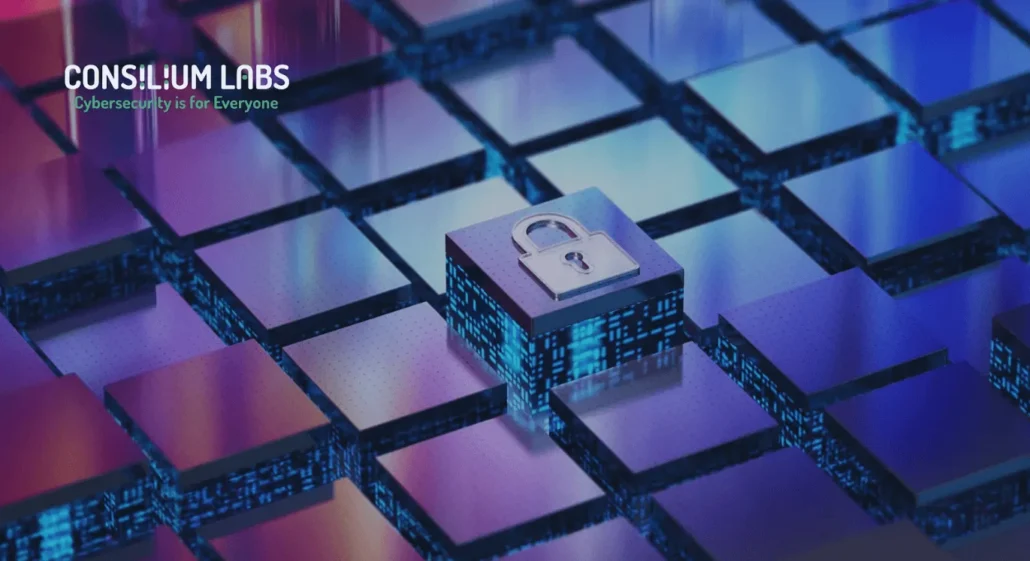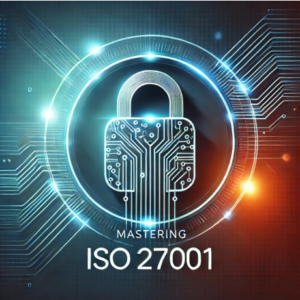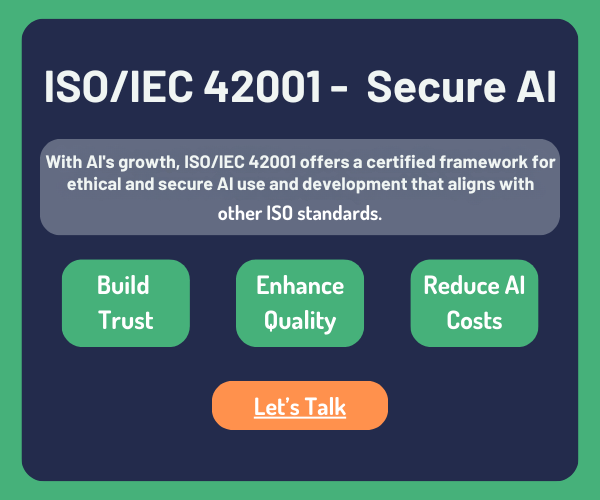AIMS, QMS, or ISMS? Unlock the Right Framework for Success
- Jorge Sandoval

Artificial Intelligence Management Systems (AIMS), Quality Management Systems (QMS), and Information Security Management Systems (ISMS) are foundational tools for managing risk, compliance, and performance in modern organizations. But while they may sound similar, each serves a distinct governance purpose.
This blog unpacks the strategic differences—and critical intersections—between these systems to help you build a future-ready compliance ecosystem.
An Artificial Intelligence Management System (AIMS) is a governance framework for ensuring that AI systems are ethical, safe, transparent, and compliant.
Introduced in ISO/IEC 42001:2023, AIMS is designed for organizations that develop, deploy, or manage AI systems. It establishes policies, roles, processes, and controls that manage the unique risks of artificial intelligence—such as bias, explainability, model drift, and human oversight.
An AIMS helps you:
- Define accountability for AI systems
- Conduct risk and impact assessments
- Manage training data, privacy, and model performance
- Align with global AI regulations (e.g., EU AI Act, NIST AI RMF)
🧠 AIMS is to AI what ISMS is to information security.
Step 1: Define AI Use Cases and Boundaries
Map all AI systems across your organization:
- What is the system’s function and scope?
- Who is affected by its outputs?
- What data, models, and vendors are involved?
This scoping step anchors your risk evaluation and ensures accurate mapping to Annex A controls.
Step 2: Assess Impact Across Risk Categories
Use a risk matrix to evaluate likelihood and impact:
- User harm (bias, discrimination, misinformation)
- Legal exposure (fines, lawsuits, compliance failure)
- Operational failure (downtime, model error)
- Reputation loss (loss of trust, brand damage)
Assign owners, document risks, and quantify the potential consequences.
Step 3: Apply Mitigation Using ISO 42001 Controls
Map identified risks to Annex A controls. Examples:
Risk | Control | Strategy |
Gender bias in recruitment AI | A.7.2 Fairness | Retrain with balanced data, validate outcome equity |
Poor explainability in loan AI | A.6.1 Oversight, A.7.3 Explainability | Introduce interpretable models + override policies |
Privacy gaps in chatbots | A.7.4 Data Security, A.5.4 Risk Controls | Anonymize inputs, monitor for data leakage |
🛠 Tip: Assign ownership. Record how each control will be implemented, validated, and maintained.
Step 4: Document the Risk Assessment
ISO 42001 requires audit-ready documentation, including:
- A formal risk register
- Justification for each applied (or excluded) control
- Evaluation of residual risk
- Links to evidence (e.g., logs, validation reports, policies)
This becomes the backbone of your AI audit and certification package.
Step 5: Review & Update Continuously
AI risk is dynamic. ISO 42001 encourages ongoing reassessment:
- New system deployments
- Model retraining or data changes
- Changes in law or industry regulation
Embed reviews into your AIMS lifecycle and schedule quarterly or semiannual assessments (NIST, 2023).
In today’s world, cybersecurity and Infosec (Information Security) are crucial. ISO 27001 helps organizations minimize the risk of data breaches, comply with regulations, and build trust with customers. The standard focuses on both preventing risks and improving your systems over time.
A Quality Management System (QMS), typically aligned with ISO 9001, governs how an organization ensures its products or services consistently meet customer expectations and regulatory requirements.
Key features of a QMS:
- Process standardization
- Continuous improvement (e.g., PDCA cycle)
- Customer satisfaction tracking
- Internal audits and corrective actions
While QMS focuses on quality outcomes and efficiency, it doesn’t address AI-specific challenges like ethical risk or explainability. However, QMS frameworks can integrate easily with AIMS to support process rigor and documentation—even if they fall outside our certification scope.
An Information Security Management System (ISMS), based on ISO/IEC 27001, is a framework that helps organizations manage their information security practices, ensuring the confidentiality, integrity, and availability of their information assets. An ISMS outlines policies, procedures, and controls to protect data from threats and vulnerabilities, ultimately minimizing business and data risk.
ISMS helps organizations:
- Protect confidentiality, integrity, and availability of data
- Conduct risk assessments for security threats
- Implement and audit controls (Annex A of ISO 27001)
- Prepare for cybersecurity certification and compliance
AI systems often rely on personal and sensitive data. That’s where ISMS and AIMS must work together—ensuring AI models handle data securely and meet regulatory standards like GDPR.
|
Feature |
AIMS (ISO 42001) |
QMS (ISO 9001) |
ISMS (ISO 27001) |
|
Scope |
AI systems, models, data, risk |
Product/service quality |
Information security and data protection |
|
Focus |
Ethics, explainability, oversight |
Process consistency, customer satisfaction |
Risk mitigation, data confidentiality |
|
Core Requirement |
Human-in-the-loop, fairness, transparency |
Continual improvement, documentation |
Asset inventory, access control, threat management |
|
Regulatory Alignment |
EU AI Act, UNESCO AI Ethics, NIST AI RMF |
Industry-specific quality standards |
GDPR, HIPAA, SOC 2, ISO 27701 |
Most compliance-driven organizations won’t choose just one framework. Instead, they’ll build a layered system where AIMS, QMS, and ISMS coexist—each supporting a different dimension of trust.
Benefits of integration:
- Efficiency: Shared policies and SOPs reduce duplication
- Scalability: Unified governance supports AI expansion
- Audit-readiness: Cross-functional compliance streamlines evidence collection
- Holistic risk management: Quality, security, and AI ethics covered under one umbrella
✅ Start with an inventory of existing governance assets—identify reusable policies, procedures, and risk registers.
✅ Map AIMS requirements to ISO 27001 (security) and ISO 9001 (quality) controls at the process level. Focus on overlapping themes like:
- Document control
- Management review
- Internal audits
- Risk assessment
- Training and awareness
✅ Expand the scope of your internal governance systems to include AI-specific workflows, systems, and vendors.
✅ Embed AIMS roles into existing compliance committees. Assign shared responsibilities for oversight and governance.
✅ Use a GRC platform to unify controls, track training, and document audits across all three frameworks.
🔄 Integration isn’t about duplication. It’s about synergy—making sure AI ethics, quality, and security aren’t siloed.
AIMS, QMS, and ISMS represent three pillars of modern governance. When aligned, they create a powerful compliance architecture that supports innovation, mitigates risk, and builds stakeholder trust.
At Consilium Labs, we help high-growth companies streamline their ISO 42001 and ISO 27001 readiness through audit-ready frameworks designed to scale.
📩 Ready to integrate your governance systems?Let’s build a compliance ecosystem that unlocks AI growth.
Related Articles
Let's get in touch
Start your audit now. Achieving cybersecurity audit can be complex. We have made it our mission to simplify the process, giving you access to the professional expertise you need to prepare your company for the future. Get in touch with us today!





